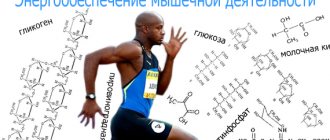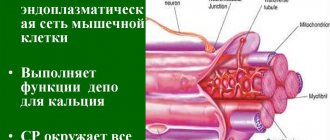Training large muscles together with small ones
Small muscle groups need to be trained together with large ones. This way, greater progress will be achieved.
This misconception was based on a previously existing theory about the connection between changes in the levels of anabolic hormones in response to physical activity and subsequent progress. Since training large muscle groups caused large hormonal changes, it was hypothesized that training small muscle groups in isolation from large muscle groups was ineffective due to little hormonal stimulation. Therefore, it is better to combine them in one workout so that the small muscles are exposed to more hormones circulating in the blood. This theory has never been confirmed and has been refuted by many studies. No connection has been established between hormonal changes during exercise and subsequent muscle growth. Large and small muscle groups progress well, both with joint and separate training. The main criterion for muscle growth is adequate physical activity and subsequent recovery, and not short-term surges of endogenous hormones.
Strength exercises: number of approaches
When performing strength exercises, it is necessary that the approaches be performed in a certain amount of time (the time the muscle group is under load). This allows for maximum hypertrophic stimulus to be achieved.
Time under load does matter, but it only characterizes one of the work parameters - volume. It is obvious that, when comparing one set of three repetitions performed to the point of failure and one set of ten, the latter will cause greater changes in the working muscles due to the greater volume of work done. But when balancing the total volume of the load by the number of repetitions performed (for example, 3x10 and 10x3), the results will be the same. True, in practice, it is more advisable to do 3X10 rather than 10X3, since a large number of approaches with such a high intensity (~90% of the max) creates excessive stress on the joints. The key parameters for triggering the maximum hypertrophic stimulus during exercise are the combination of load intensity and its proximity to failure. High intensity and/or performing approaches close to failure promotes maximum muscle fiber recruitment and, accordingly, a larger number of muscle cells that are subject to load and all the intracellular changes that accompany it, incl. enhancing protein synthesis. The time during which the maximum number of muscle fibers are involved in work is limited due to fatigue. Scientists studying adaptive hypertrophy have found that approximately the last 5 repetitions of a set, performed to failure or almost to failure, have the greatest stimulus. For this reason, studies of different repetition ranges in sets show no significant difference in muscle growth between 5, 10 and 30 repetitions, even though these are significantly different intensities (from 85 to 50% of max) and duration under load. In the first case, all 5 repetitions are accompanied by maximum recruitment of muscle fibers, in the last 5 final ones. That is, the effectiveness of low-intensity training is more dependent on working to failure than high-intensity training. The guideline for organizing training is to choose not a specific time for the duration of approaches, but an adequate intensity (allowing you to do from 5 to 30 repetitions) with which you can perform certain exercises with the highest quality, both technically and in terms of work at the limit of its capabilities. Not many people are able to perform 30 reps of barbell squats to actual muscle failure, as the increasing fatigue and resulting discomfort (high heart rate, hypoxia, burning) can lead to a false sense of working at the limit. The exercise will cease to be performed due to general fatigue, and not fatigue of the leg muscles. On the other hand, working with too high an intensity can lead to a violation of the technique of the exercises performed, the use of inertia, dissipation of the load, failure to hit the target muscle groups and overload of the joint-ligamentous apparatus. For this reason, the most commonly used rep range in bodybuilding is the medium rep range of 8-12. For such a range, the intensity is quite high, but not excessive, and the approaches do not cause severe general fatigue, which prevents you from concentrating on the work of specific muscles.
Special techniques for increasing training intensity[edit | edit code]
It has been proven[2] that people who do high-intensity training (for example, 30 minutes of running for women and 40 minutes of running for men) 5 days a week look 9 years younger than their biological age. The study was conducted on 6,000 adults aged 20 to 84 years.
People who have been training with weights for years are familiar with the concept of stagnation. Everything seems to be going as it should. Feeling great, good working weight, a training program worked out to the smallest detail and a balanced diet.
But there is no muscle growth, no increase in strength indicators. The body got used to the stress and adapted. Of course, increasing the weight of the barbell, dumbbells and increasing body volume could not continue indefinitely, but this is not the end. At least not for you and not now. Use some intensity techniques to make your workout not only more interesting, but also more productive. Working at your limit will increase the intensity of your workout.
Small rest breaks[edit | edit code]
Let's start with the simplest thing - reducing rest pauses between sets.
In your normal workout, reduce the working weight by 5-10%. Leave the number of sets and repetitions unchanged. Reduce rest breaks to 30-45 seconds. This will reduce your overall workout time, leaving your muscles more time to recover. By doing several of these workouts in an unusual mode, you will give your muscles excellent training stress. Train like this for 2-3 weeks, after which return to your regular program.
Increasing the number of repetitions[edit | edit code]
If for the last few months you have been training to increase muscle mass or strength, performing 3 to 8 repetitions per set, then increasing their number to 15-20 while simultaneously decreasing the weight by 20-25% will not leave your muscles indifferent. This will not only show your fighting spirit,
but there will also be an opportunity to build endurance. Perform exercises that are familiar to you at a familiar pace. Get enough rest between sets, just increase the number of reps per set. Leave the number of sets the same. Train in this style for 2-3 weeks, and then return to your previous training.
Increasing training weight, working on strength[edit | edit code]
If your goal lately has been to gain muscle mass or endurance, then try strength training, namely:
- formulate a new training program in which the dominant role will be given to heavy basic movements (deadlifts, squats, presses, snatches);
- reduce the number of repetitions per set to 3-5;
- increase your training weight by 15-20%;
- increase the number of sets to 5-6;
- make rest breaks longer - up to 3-4 minutes.
Transition to a new style of training smoothly, under the supervision of a coach or training partner who can back you up and more objectively evaluate the process of increasing working weight. Spend one week retracting, then train for strength for 8-10 weeks. At the end of this cycle, do a “walk”, that is, find out how much weight you can lift in one repetition in the main movements (squat, bench press, deadlift). To do this, break the 11th week into 3 workouts.
On the first, perform a squat, on the second, a bench press, and on the third, a deadlift.
The “passage” itself will look like this. In the first set, you put on the bar the weight that you can easily lift for 8 reps, but lift it for 6 reps. In the second set, add 10-15% to this weight and lift it 3 times. In all subsequent sets (from 3 to 5), add 10% and perform one repetition. The heaviest weight will be your maximum strength.
The process is long, but strength is the basis for muscle growth. As you get stronger, you will inevitably get bigger. Judge for yourself, if before this program you stressed your pectoral muscles with a bench press of 100 kg in 6 repetitions, then by increasing your strength indicators, you will be able to bench press 110, or even 120 kg for the same 6 times! Will the muscles not grow?!
Speed training[edit | edit code]
Imagine that you are driving a car or bicycle on a flat road. Ahead is a gentle but protracted climb. Of course, you will try to increase your speed before the rise in order to pass it with less effort. The same thing happens with a barbell or dumbbells. As an example, consider the bench press.
Having lowered the barbell to your chest, you begin to press it up.
And the more powerful the barbell starts from your chest, the faster it will go through the entire trajectory. The main thing here is speed. Developing movement speed with proper technique is a precursor to strength training. Speed - strength - mass - this is the order in which muscles grow.
Now about the speed workout itself. After a good warm-up, set a weight on the barbell equal to 60% of your maximum, and press it at a fast pace for 3 times. With short rest pauses (30-45 s), perform 10 sets. Use this approach only in basic movements (presses, deadlifts, squats, pushes).
For the remaining exercises, simply lighten the weight a little and perform them at speed.
The approximate duration of such a cycle is 3-5 weeks.
Complex sets and circuit training[edit | edit code]
For a more varied workout of any muscle group, select 2-4 exercises. Do them without a break for 6-8 repetitions for each - this will count as one set. Perform 3 to 5 sets. Thanks to complex sets, the working muscle group will be under load for more time during training. The workout itself will be significantly shortened, which will add time for recovery. The working weight in the selected exercises, of course, will have to be reduced. Include this technique in your workouts occasionally.
By combining several exercises for all muscle groups into one set, you get a circuit workout. Given its high intensity, practice circuit training no more than once a month. The circuit training itself should consist of 2 or 5 circuit approaches.
Supersets[edit | edit code]
The next high-intensity technique is based on the principle of antagonism. You choose one exercise for the antagonist muscles (quadriceps - hamstrings, biceps - triceps, pectorals - lats) and form one full set from them. For example, machine curls (biceps) and push-ups (triceps).
Do arm curls for 8 repetitions and immediately (without rest) push-ups with narrow arms for 10-12 reps. Perform 3 to 5 such sets. Include supersets in your workout once every few weeks.
Forced reps[edit | edit code]
For this and some other high-intensity moves, you'll need a good partner. Not only the quality of your workout, but also your health and the likelihood of avoiding injury will depend on it. So, forced reps.
Imagine that you are doing a barbell curl.
This is the last exercise in biceps training. You lift the barbell the usual 8 times, feel tired in your muscles, but instead of lowering the apparatus to the racks, you perform another, ninth repetition. And even after that, you don’t finish the set, but decide to do one more repetition. Smoothly and under control, lower the barbell down and begin the lift, in which your partner helps you quite a bit. With this you perform 2 more reps. The result is 11 repetitions instead of the usual 8. Use this technique for a maximum of two exercises per workout, no more than once a week and for different muscles.
Negative repetitions[edit | edit code]
Negative repetitions, like forced ones, are performed with the help of a partner or coach. The only difference is that he will lift the weight for you, and you will only get the negative phase.
At the end of the bench press after two forced reps, you do not release the barbell from your hands, but slowly lower it to your chest. After this, the partner, taking all the weight, lifts her to the starting position. You lower again... Perform a maximum of 2 repetitions.
Practice negative repetitions no more than once a month and for different muscles. However, this technique is absolutely not suitable for exercises with dumbbells and deadlifts.
All of the above examples can be included in the training process not only when there is stagnation in training. Using some of them with a certain frequency, you can avoid this stagnation and increase the effectiveness of your training.
Step sets[edit | edit code]
Another technique for which you will need a partner. Although in some exercises, especially with dumbbells and on machines, you can do it yourself. For example, when bench pressing dumbbells.
Last set, last rep. You lower the dumbbells to the floor and, taking lighter dumbbells, continue the exercise. After 2-3 repetitions, change the weight again. And so on until 3-5 weight changes.
Basic muscle exercises are more effective than isolation exercises
Basic (multi-joint) exercises are more effective for muscle growth than isolating (single-joint) exercises.
Studies comparing programs consisting of only multi-joint or single-joint exercises do not show a clear advantage in the growth of pleasure muscles or other muscles. And in exercises for the muscles involved in extension of the spine, isolating exercises are even more effective. In fact, speaking about a specific muscle group, its growth depends solely on the quality of the load it receives, and not on whether the synergists and agonists also receive a load on the muscles. And complex work of several muscles at the same time can even negatively affect the development of the main muscles, since due to the anatomical characteristics of the athlete or his motor skills, synergists and agonists can be dominant in the exercise and limit the achievement of failure in the target muscle group. For example, not everyone is able to technically correctly perform basic movements in order to target the middle and rear deltoids or buttocks. And there are no full-fledged multi-joint exercises for the lower leg muscles.
On the other hand, the participation of several muscle groups is the main advantage of basic multi-joint exercises, because allows you to increase the total volume of load on the accompanying muscles, which, as a rule, are also loaded separately. If in a weekly cycle the arms and shoulders are loaded in a separate workout, then they will receive additional load on the day of working with the back and chest. Isolating exercises, in addition to the fact that they “hit” the right place more precisely, can eliminate some of the shortcomings of the basic ones. In complex hip movements (squats, presses, lunges), biarticular muscles such as the rectus femoris and hamstrings receive little load due to their uncoordinated work, accompanied by simultaneous stretching and contraction. They can be fully loaded only by working in one joint (extension, flexion, hyperextension, traction)
Training Amount
The value is the total load on the body that you and I gave it during training. That is, when the load is not on a specific system, for example, a muscular one, but also on the central nervous system, immune system, microdamage to tissue, and so on.
The load will increase if we replace isolation exercises with basic ones. In this case, the load on the entire body will be greater, the stress will be stronger. You can estimate the amount of load based on your own feelings, giving an assessment of your training and fatigue after it from 1 to 10 points.
With one point we feel as if we haven’t trained, and with 10 points we can barely crawl out of the gym and can’t stand on our feet, which is clearly not good, unless of course we are talking about shock training.
Training to failure in bodybuilding
In bodybuilding, it is customary to perform exercises to the point of extreme fatigue. This means working to failure or almost to failure. The existing body of research shows that working half-heartedly, without noticeable fatigue during the approach, is not very effective. The goal of achieving pronounced fatigue is to involve as many muscle fibers as possible. During the exercise, fatigue increases and this contributes to the recruitment of an increasing number of muscle fibers involved in the work, thus, the closer the completion of the exercise is to failure, the greater the likelihood of subjecting the largest number of muscle fibers to the stimulating effect of the load and, accordingly, obtaining a greater degree of hypertrophy as a result. However, when working with small and medium weights, it is possible to achieve maximum involvement of muscle fibers in the work only towards the end of the approach, and with heavy weights this happens almost from the very first repetitions. Thus, the relevance of working to failure is most evident under loads of medium and low intensity. High-intensity loads show the same effectiveness both when working to failure and almost to failure. In addition, the athlete’s training experience matters. A more experienced athlete has a better developed neuromuscular system, which allows him to more effectively recruit muscle fibers during the exercise, and working to failure is not as important for him as for a beginner. In addition, an experienced athlete, due to the presence of technical skills, is able to quickly develop metabolic stress in the muscles, which also contributes to the recruitment of muscle fibers. An experienced athlete is able to achieve pronounced muscle fatigue in a short period of time, working even with light weights. This is what we observe in practice: the higher the athlete’s experience, the more often he uses lighter weights in training, and this does not lead to a significant increase in the number of repetitions in the approaches. Studies involving experienced athletes, as opposed to untrained participants, do not show the superiority of failure over “near failure.” The “work hard” rule was and remains the basis for organizing the training process in bodybuilding, but at the same time, you should not idealize working to failure or even beyond failure, although failure still remains the most clear and specific guideline to which you should strive to get closer while performing weight-bearing exercises.
Training intensity and volume
The intensity increases with:
- »Increasing the weight of the weight and decreasing the number of repetitions
- » Approaching the failure state in the last repetitions of the sets
- »Reducing the pause between sets
- »Increasing driving speed
Volume increases when:
- »Increasing weight without decreasing the number of repetitions
- »Increasing the number of repetitions in a separate approach
- »Increasing the number of approaches per exercise
- »Increasing the number of exercises in your workout
Tags: workout intensity, workout volume, workout duration, workout size
Author: ForceMan from 08/18/2015, 07:26
- 3
Rest between sets
There are conflicting recommendations regarding how long you should rest between sets. Some say that the rest should be short (within 1-1.5 minutes), others, on the contrary, pronounced (3-5 minutes), others add that the rest should be fixed, that is, the same time between approaches one exercise. However, there is currently a lack of evidence to support the claim that rest interval length has an effect on muscle hypertrophy.
Due to the lack of longitudinal studies that directly measure changes in muscle volume, previous recommendations for rest intervals between sets in strength training programs aimed at promoting muscle hypertrophy were primarily based on the hormonal response related to the post-exercise period. , and other mechanisms theoretically associated with muscle growth. Of the studies measuring long-term muscle hypertrophy in groups using different rest intervals, none found superior muscle growth in groups with short rest intervals compared to long rest intervals, and one study found the opposite. Rest intervals of less than 1 minute can cause a sharp increase in the level of growth hormone in the blood and reduce the ratio of testosterone to cortisol. But hormonal changes in response to exercise and subsequent muscle growth are not directly related. The relationship between the indirect effects of rest intervals on immune system response, muscle damage, metabolic stress, and muscle hypertrophy is still controversial and largely theoretical. Current literature does not support the hypothesis that training for muscle hypertrophy requires shorter rest intervals than training for strength development, or that predetermined rest intervals are preferable to those that are controlled by sensation.
Current practice is usually based on the fact that:
- rest between sets in isolation exercises is less than in basic (multi-joint) exercises
- rest after an approach performed with a large weight longer than after an approach with a small one
- after an approach performed not to failure, you can rest less, the further you go to failure, the shorter the rest can be
What all of the above have in common is that they all follow the rule: rest between sets must be sufficient to successfully complete the intended training plan. This means that all approaches must be implemented with the highest possible degree of efficiency, while maintaining the correct technique for performing the exercise. That is, if according to the plan you have 4 sets of 10-12 repetitions, but in the 4th approach you do only 5-6 repetitions or 10-12, but due to distortion of the technique, for example, by cheating, this is not the best a way to stimulate muscles to grow. A well-conducted training is the basis for maximum training stimulus and further progress, regardless of the presence or absence of pharmaceutical support. Quality here means that in each exercise the athlete demonstrates maximum performance, and not limited at a given time by the influence of external and internal factors. Rest between sets is one of the variables we control to ensure this quality is achieved. Therefore, the exact, specific figure will be selected by the athlete himself, based on the technical complexity of the exercises, the intensity and volume of the load, as well as recovery abilities (which depend, among other things, on the individual muscle composition of individual muscle groups, for example, the pectoral muscles, as a rule, take longer to recover after a set than the calf ones). The most commonly used rest range between sets in the practice of bodybuilders falls within the interval of 1-5 minutes. This is a guideline that you can continue to adhere to.
How long should the intervals run?
To understand interval training, keep in mind that all intervals are performed at the fastest speed you can sustain for the entire set of intervals.
The combination of the number of intervals, the length, and the rest between intervals determines the goal, not the other way around. The higher the intensity, the less time you can withstand. This shouldn't be news to you. If you run at the maximum intensity you can sustain for three minutes, it will be a very tough test. The perceived effort for the fastest pace you can sustain for 20 minutes will be lower, but it is still the fastest pace you can maintain for the entire time.
Here's how I see the five key workouts:
| Name | intensity level | example |
| recovery run | restorative | 40 min. |
| distance running | aerobic zone | 2 hours |
| consistently fast running | upper part of the aerobic zone | 2 hours, of which 2x30 minutes at target pace, rest 5 minutes. |
| tempo run | lactate threshold | 2 hours, of which 3x12 minutes at target pace, rest 6 minutes. |
| intervals V02 max | V02 max | 90 minutes, of which 6x3 minutes at target pace, rest 3 minutes. |
Here are detailed descriptions of typical workouts:
| Name | RPE (perceived level of exertion?) | intensive interval duration | total time at target pace | work/rest ratio |
| recovery run | 4- 5 | — | 20-60 minutes | — |
| distance running | 5- 6 | — | 30 minutes - 6 hours | — |
| consistently fast running | 7 | 20-60 minutes | 30 minutes - 6 hours | 5- 8:1 |
| tempo run | 8- 9 | 8-20 minutes | 30-60 minutes | 2:1 |
| tempo run | 10 | 2-4 minutes | 12-24 minutes | 1:1 |
The goal of interval training is to maximize the time spent exercising at a specific intensity. For VO2 max intervals, this means creating a specific structure (number of intervals - rest period time - intense period time) of intervals that is optimal for achieving and maintaining an effort greater than 90% of your VO2 max. The figure below is from a study by Seiler and Sursen that examined the physiological response to 1-, 2-, 4-, and 6-minute intervals at VO2 max with 1:1 work:rest ratios. Although each workout includes 12 minutes of pure "stress" time, you may see differences in cardiovascular response as the intervals get longer. They found that athletes achieved maximum oxygen consumption during 4-minute intervals. In practice, intervals between 2-4 minutes are long enough for the athlete to “accelerate” to the desired intensity and maintain it throughout the entire interval. When athletes do six-minute intervals, they are likely doing them too slowly.
Concentric and eccentric phase of the exercise
In strength training aimed at developing hypertrophy, the eccentric and concentric phases of repetitions are equally important. The meta-analysis, which looked at studies where participants had to do either concentric or eccentric strength training alone, found that concentric-only strength training alone resulted in an average gain of 6.8 percent in muscle mass, and eccentric-only strength training resulted in an average gain of 6.8 percent. The difference between the effectiveness of each type of strength training is borderline significant—and therefore not entirely statistically significant.
Purely concentric strength training means that you only use your muscles to lift the weight and lower it back down without any resistance. Exclusively eccentric strength training is the opposite of this. An assistant or special device lifts the weight for you, and you only use your muscles to lower the weight in a controlled manner. In reality, bodybuilding exercises are always performed in both phases, but at different speeds. If in the concentric phase acceleration (and not inertia) is the way to increase the load, then quickly lowering the projectile in the eccentric phase leads to a decrease in the load on the muscles. For this reason, to get the most out of both phases, exercises should be performed focusing not only on lifting the apparatus, but also on lowering it. There is no need to purposefully extend the eccentric phase over time (although this is not prohibited), but the lowering must be controlled. This will already be enough.
Specifics in interval training
To increase training specificity, we target specific intensities or tempos that correspond to the adaptations we want to target.
This is where one of the first and biggest misconceptions arises. Too often, coaches and athletes refer to "energy systems" training. In this flawed theory, each "system" has a discrete range of intensity and associated adaptation. Train in the range, and the training will benefit. Train outside the range and the training is "bad". The problem is that there are no switches that say you use your aerobic system at this pace, your anaerobic system at this pace, and so on.
Your body does not know such “systems”! Therefore, exercise of any intensity affects all aspects, it's just that certain parts of your physiology are stressed more or less, depending on the intensity. So when we do intervals to develop VO2 max, what this means is that the interval will primarily, but not exclusively, improve your performance around VO2 max. Your other qualities will also improve (lactate-level power, distance endurance, etc.), but the greatest improvements will be achieved at a certain intensity.










